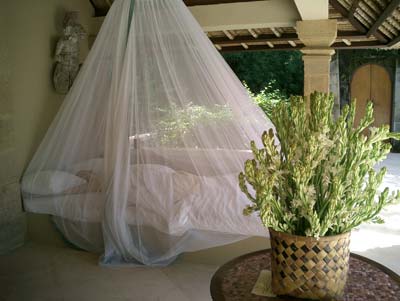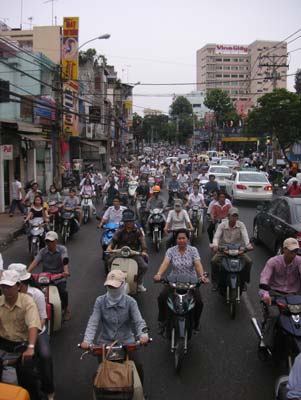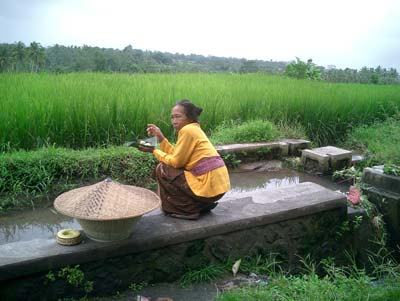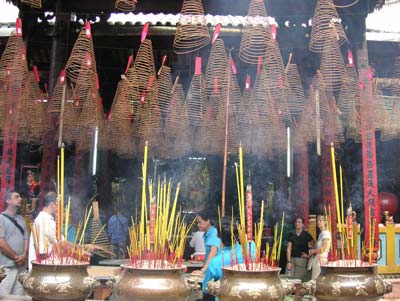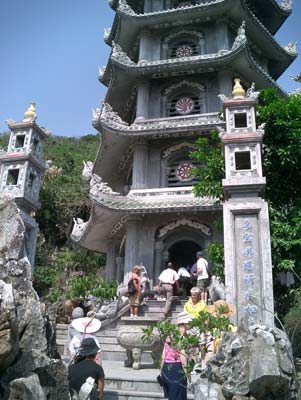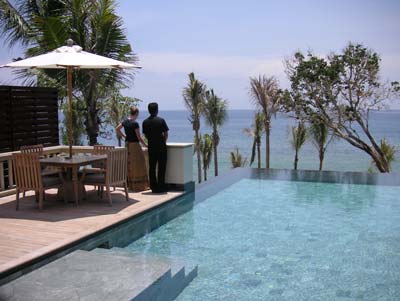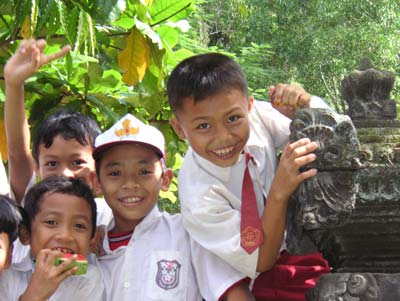Looking for luxury in Vietnam, Thailand, & Bali
by Bill Kizorek, Lisle, IL
International travel: the phrase conjures up visions of adventure and exploration. There are so many ways to go about it. When I am by myself, I don’t care if I sleep in a tent in Botswana with hippos grunting through the canvas or eat breakfast at a camp table across from a yellow-eyed camp attendant recovering from malaria.
Traveling with Janie and Carly, my wife and daughter, is a different story.
Although they also like to poke their noses into different cultures, both like to revel in the joys of heavenly mattresses, massages and culinary pampering. This trip offered large doses of the latter.
Asia, noted for its creature comforts, was our destination — Vietnam, Thailand and Bali. It would be a combination of group and independent travel through an emerging nation striving to attract travelers plus two other countries with reputations for knowing how to dazzle their visitors.
A good deal
Gate 1 Travel opened the adventure with a remarkable 12-day journey through Vietnam. It amazed me how they could weave together a network of hotels, guides, tours, planes and buses for such an affordable price. (For 2007, prices start at $1,699 per person.)
This tour was an immersion into an incense-fogged odyssey through Vietnam.
The trip launched in Ho Chi Minh City (Saigon) and wound its way up through Hué, Da Nang, Hoi An and Hanoi. It would be of little value to the reader to quote the rates for the hotels along the way, as the published rates for the rooms alone, if added up, exceeded the entire cost of the Gate 1 trip including guides, buses, food, airplanes, boats and rickshaws.
Measuring up
If comparing the three destinations on the pamper-meter, Vietnam finishes a solid third. Bali and Thailand have been, for centuries, perfecting the art of comforting their foreign visitors. Although the sights in Vietnam are colorful and provocative, they must sometimes be viewed through eyes made itchy by the constant burning of three billion incense sticks.
Whatever else contributed to the air quality, I had scratchy eyes for the entire trip — whether in the city or countryside.
I liked my hotel room in Hué, which was huge, with tall ceilings and an old French Colonial feeling, but Janie wasn’t as keen on the Saigon Morin (30 Le Loi St., Hué; www.morinhotel.com.vn).
In Saigon, however, we both agreed that the traffic was unsettling. During “rush hour,” the stream of motorcycles was so relentless that there was never a good time to cross the street. We just waited for a local to start crossing and stayed as close as we could, walking directly in front of the line of cycles.
Perhaps in part because of all the group meals, the Vietnamese cuisine fell a little short of our expectations. The country is so close to Thailand that I thought there would be more similarities in the food, but in general I found the Vietnamese food we had kind of boring and a little on the heavy side. A welcome respite was the Bangkok-Hanoi Restaurant (52A Ly Thuong Kiet, Hanoi).
Another restaurant that was thoroughly charming, perched on the bank of a river, was the Son Restaurant (Thanh Tay, Cam Chau; phone 84 510 861 172), just two blocks away from the Hoi An Riverside Resort in Hoi An (Janie’s favorite hotel).
A few recommendations
Traffic and food and air quality aside, Vietnam is a country worth visiting. I spent 15 months as a G.I. there in the ’70s and was proud of my army service. But after many days of getting the other side of the story, I spent some time in contemplative reflection about the entire war.
All vets who go back should take a crawl through the Cu Chi Tunnel complex (www.cuchitunnel.org.vn), 70 kilometers to the north of Saigon. If you are claustrophobic, stay aboveground.
You can also fire an AK-47 here for a dollar a round, and you will be put through a mild indoctrination about our barbaric conduct during the war. Another eye-opener was the Hoa Lo Prison, what was called the “Hanoi Hilton,” in Hanoi, where Senator John McCain was held captive.
Vietnam is learning as it opens itself to foreign visitors. The ethnic charm, the idyllic landscapes, the vibrant colors and even the climate are enormously attractive. As a traveler, however, be prepared to get scraped on the rough edges. There is a slightly militaristic attitude on the part of many who are in contact with visitors. Don’t take it too personally.
If you are a lover of art, however, you should take Hanoi very personally — and seriously. Veteran Asia travelers rate Hanoi above Shanghai when it comes to fine paintings. We ended up shipping three home via DHL. Our favorite source was the Mai Gallery (3B Phan Huy Chu;
e-mail maigallery@fpt.vn), located in the center of Old Hanoi.
On to Thailand
Thailand was as enchanting as ever. Bangkok is a nonstop, pulsating, vibrant city of courteous and charming residents. Our base of operations was the inimitable Sukhothai Hotel (13/3 South Sathorn Rd.; www.sukhothai.com). The hotel’s spa boasts décor and services that can compete at world-class levels, and the hotel’s morning breakfast buffet sets the bar for the standard of excellence. Our stay here was the beginning of the total luxury portion of our Asian journey. Room rates start at 12,000 baht ($368).
Following the compass south, the Trisara (60/1 Moo 6, Srisoonthorn Rd.; www.trisara.com) in Phuket was the second in line of our litany of extraordinary hotels. It was outstanding. This is truly a “Lifestyles of the Rich and Famous” kind of place. Even if you are a multibillionaire used to the highest level of luxury, you should try this place on for size.
We stayed in a seaside 2-bedroom villa, a solidly constructed modern structure with an expansive patio and an infinity pool.
Rates at the hotel can easily run over a thousand dollars a night for the seaside villas (room rates start at $556 per night), but they run package specials worth checking out. We paid less because we were working on a Thai tourism video assignment.
The place is run by the fellow who used to run the nearby Amanpuri, where we stopped for a phenomenal tequila/passion fruit drink — the best drink of the entire trip. The service, however, both in trying to get a waiter and then trying to pay for the bill, was very “non-Aman.” I almost got the impression that they discouraged nonresidents from bothering them at the bar.
Bouncing back
Patong Beach, the center of tourist activities and within the strike zone of the great tsunami disaster, is a half-hour ride from the Trisara. The beachfront stores were, for the most part, open, but some hotels were still shuttered or undergoing massive post-tsunami renovations.
One tailor shop manager on the beach road, about a block from the ocean, showed me the level (seven feet high) to which the water surged through his shop. He also gave me a message, one that was repeated over and over again: “Please tell your countrymen we miss them. Phuket is open for business.”
There are fleets of new taxis and hundreds of brand-new fishing boats, many of them not yet even painted. Otherwise, there were few signs that this island was crushed by a tidal wave, only many Thais with their incomparable warmth and welcoming ways. Thai people, Thai food: they continue to be the reasons that Thailand stays at number one on my list of foreign destinations.
It used to be that way for Carly and Janie, too, but on this trip there was a shift. Carly had a distressing experience at the Patpong night market, and Janie was seduced by our next stop.
Balinese enchantment
We moved on to the Indonesian island of Bali. After our stay at the Trisara in Phuket, the bar had been raised. None of us thought that the Aman resorts in Bali could compete; the Trisara was just too cool of a place.
Then we began our 12-day journey across Bali and put ourselves in the hands of the staff of each of the Aman resorts in which we stayed: Amandari, Amanusa and Amankila.
Each resort was a world of its own, each different in its location and structure but similar in the treatment of its guests — sensitive, aware, personal and dedicated. The lodgings were as attractive as the country, and the country was very, very attractive.
Having heard travelers’ tales for years, tales of adoration ad infinitum, I was convinced that a letdown was assured. By the end of our Balinese immersion, Bali would become my wife’s and daughter Carly’s favorite destination.
Bali is what you imagine: lush vegetation, mountains, handicrafts, silk-clothed elegant women and congenial men. The shopping in the craft center of Ubud was so interesting and expansive that Janie wanted to go back and spend 10 days in Ubud alone. The town was a short shuttle ride from the Amandari.
Accommodations
As far as the three resorts go, they were exquisite. First, here are the things that were the same at all three hotels.
We never signed a check at the restaurant. They always knew who we were when we came in. Whatever the bill was for drinks, food or at the gift shop, we saw the totals only upon checkout.
The restaurants were flawless and the room service, timely. Huge bowls of fruit and flowers were de rigueur in the rooms, and beautiful floral arrangements abounded throughout the properties.
The staff was always well dressed, attentive (but not obsequious), soft spoken and friendly. I would like to give more restaurant reviews for Bali, but the Aman hotel meals were so attractive and reasonably priced (for a luxury resort), there was little incentive to eat out.
Amandari, in Ubud, was my personal favorite. It is nestled amongst the rolling rice paddies of central Bali.
Just next to the hotel, Carly and I took one wild raft ride on a river which featured class III and IV rapids — wild, drenching, soaking rapids.
Amankila, overlooking the ocean and in the middle of nowhere, was one spectacular place to spend time. Carly celebrated her 20th birthday there and the staff, who knew she loved passion fruit (about $3.50 apiece in Chicago), brought her a plate of 20 for her room-service birthday breakfast.
Amankila was her favorite. Janie agreed.
Because we were working on a video project for tourism, the Aman public relations department arranged for special rates but also asked that we visit all three of their Balinese resorts. I did not want to leave Amandari to go to Amankila. Janie and Carly fought to stay at Amankila. And we all relented and ended up at Amanusa for the final portion of our stay.
The Amanusa Resort in Nusa Dua is in the most cosmopolitan part of the island, around Denpasar and Kuta. Nightclubs, fine dining, massages, art galleries and other diversions of civilization make this the resort of choice if you are looking for excitement — or golf. The lavish tropical course snakes around the resort.
This resort was the only of the three where we had a television in the room.
Although the Sukhothai still ranks number one in the big city/favorite country category, the Aman chain has, forever, won a place in my heart. Room rates for all three resorts start at around $700 per night. Special package rates are available.
Summing up
If fine paintings are your game, there is hardly a place in the world were the quality and value equals that in Hanoi. If 24-hour-a-day action is the ticket for you, fly yourself to Bangkok or move farther south to the Denpasar/Kuta area of Bali.
In the end, all three of these countries are winners as travel destinations. What order you put them in is up to you. I would go back to any of them tomorrow.


